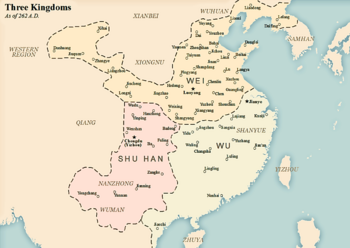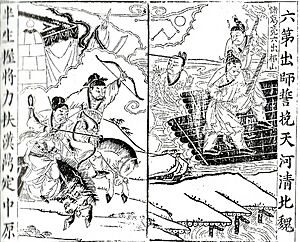Shu Han facts for kids
Quick facts for kids
Han
漢
|
|||||||||
|---|---|---|---|---|---|---|---|---|---|
| May 221–c.Dec 263 | |||||||||

The territories of Shu Han (in light pink), as of 262 A.D.
|
|||||||||
| Capital | Chengdu | ||||||||
| Common languages | Ba–Shu Chinese Eastern Han Chinese |
||||||||
| Religion | Taoism, Confucianism, Chinese folk religion | ||||||||
| Government | Monarchy | ||||||||
| Emperor | |||||||||
|
• 221 – 223
|
Liu Bei | ||||||||
|
• 223 – 263
|
Liu Shan | ||||||||
| Historical era | Three Kingdoms | ||||||||
|
• Established
|
May 221 | ||||||||
| c.Dec 263 | |||||||||
| Population | |||||||||
|
• 221
|
900,000 | ||||||||
|
• 263
|
1,082,000 | ||||||||
| Currency | Ancient Chinese coinage, Chinese cash | ||||||||
|
|||||||||
| Today part of | China Myanmar |
||||||||
| Shu Han | |||||||||||||||||||||||||
|---|---|---|---|---|---|---|---|---|---|---|---|---|---|---|---|---|---|---|---|---|---|---|---|---|---|
| Traditional Chinese | 蜀漢 | ||||||||||||||||||||||||
| Simplified Chinese | 蜀汉 | ||||||||||||||||||||||||
| Hanyu Pinyin | Shǔ Hàn | ||||||||||||||||||||||||
|
|||||||||||||||||||||||||
The Shu Han (pronounced Shu HAHN) was an important kingdom in ancient China. It existed from 221 to 263 AD. This kingdom was one of the three main states that fought for control of China during a time called the Three Kingdoms period.
Shu Han was located in the western part of China. This area includes parts of what we now call Sichuan, Chongqing, and Yunnan. The kingdom's founder, Liu Bei, named his state "Han." He believed his kingdom was the true continuation of the earlier Han dynasty. The name "Shu" was added later by other historians to tell it apart from other "Han" states.
Contents
History of Shu Han
How Shu Han Began
Towards the end of the Eastern Han dynasty, China was in chaos. Many powerful leaders, called warlords, fought for control. One of these warlords was Liu Bei. He was a distant relative of the Han imperial family. Liu Bei gathered many smart and brave followers.
With the help of his clever advisor, Zhuge Liang, Liu Bei gained control of several important areas. He took over parts of Jing Province in 208 and 209. Then, he conquered Yi Province (modern-day Sichuan and Chongqing) between 212 and 214. In 219, he even took Hanzhong from his rival, Cao Cao. After these victories, Liu Bei declared himself the "King of Hanzhong."
However, Liu Bei's alliance with another warlord, Sun Quan, broke apart. In 219, Sun Quan's general, Lü Meng, attacked and took over Jing Province. Liu Bei's general, Guan Yu, was captured and killed by Sun Quan's forces. This was a big loss for Liu Bei.
In 220, Cao Cao died. His son, Cao Pi, took over. Cao Pi forced the last Han emperor to give up his throne. Then, Cao Pi started his own kingdom, called Cao Wei, and declared himself emperor. Liu Bei believed Cao Pi was not the rightful ruler. So, in 221, Liu Bei declared himself "Emperor of Han." He saw his new state, Shu Han, as the true continuation of the Han dynasty.
Liu Bei's Time as Emperor
Liu Bei ruled as emperor for less than three years. In 222, he launched a big attack against Sun Quan. He wanted to get Jing Province back and get revenge for Guan Yu's death. This led to the Battle of Xiaoting.
However, Liu Bei made some big mistakes. His army suffered a huge defeat against Sun Quan's general, Lu Xun. Liu Bei lost most of his soldiers. He managed to escape to Baidicheng, where he became sick and died a year later.
Liu Shan's Time as Emperor

Before Liu Bei died, he chose his son, Liu Shan, to be the next emperor. Liu Shan was only 16 years old. Liu Bei asked his trusted chancellor, Zhuge Liang, and general Li Yan to help Liu Shan rule. Zhuge Liang became the main leader of the Shu government for most of Liu Shan's reign. He made most of the important decisions.
When Liu Shan became emperor, Shu Han was the weakest of the three major kingdoms. After Liu Bei's defeat, the eastern lands were controlled by the kingdom of Wu. The northern lands were controlled by Wei. Shu Han only had the western lands of Yi Province. Shu Han also had a smaller population. This meant they had fewer resources and soldiers.
Because of this, Zhuge Liang made peace with Wu. He made sure their alliance was strong again. He even recognized Sun Quan as the "Emperor of Wu" when Sun Quan declared himself emperor in 229. To make Shu Han stronger in the southern regions, Zhuge Liang also led a military trip in 225. He wanted to stop local rebellions and the growing influence of tribes in the area.
Zhuge Liang believed that attacking Wei was important for Shu Han to survive. Between 228 and 234, he led five military campaigns against Wei. His goal was to capture Chang'an, a key city on the way to Wei's capital, Luoyang. Most of these battles happened in what is now Gansu and Shaanxi provinces. However, Shu Han did not win any major victories or gain much land. During his last campaign, Zhuge Liang became very sick and died while fighting the Wei general, Sima Yi, at the Battle of Wuzhang Plains.
After Zhuge Liang's death, other leaders like Jiang Wan and Fei Yi took charge. Shu Han stopped attacking Wei for a while. In 244, Wei tried to invade Hanzhong. Even though Shu Han had fewer soldiers, they defeated the Wei army at the Battle of Xingshi. The Wei forces had to retreat in shame. Between 247 and 262, the Shu general, Jiang Wei, continued Zhuge Liang's plan. He led several military campaigns against Wei, but he also did not gain much land.
The Fall of Shu Han
In 263, armies from Wei, led by generals Deng Ai and Zhong Hui, attacked Shu Han. They captured its capital, Chengdu, without much difficulty. The kingdom was tired from Jiang Wei's many battles. In the same year, Liu Shan surrendered to Deng Ai outside Chengdu. This marked the end of Shu Han.
Jiang Wei tried to cause trouble between Deng Ai and Zhong Hui. He hoped to use this to bring Shu Han back. Zhong Hui captured Deng Ai and openly rebelled against Wei. But the rebellion was stopped by Wei's forces. Jiang Wei, Zhong Hui, and Deng Ai were all killed in the fighting.
Liu Shan was taken to Luoyang. There, he met with Sima Zhao, a powerful Wei leader. Liu Shan was given the title "Duke of Anle." He lived a comfortable and peaceful life in Luoyang until he died.
Economy and Daily Life
Shu Han was not always at war. During times of peace, the government worked on many projects to improve the economy. They built irrigation systems to help farming and constructed roads to make trade easier. Many of these public works still exist today! For example, the Zipingpu Dam is still near Chengdu, Sichuan.
These projects helped the economy of southwestern China grow. They also made it easier to trade with southern China, which was controlled by the Eastern Wu kingdom.
Emperors of Shu Han
Here are the main rulers of Shu Han:
| Emperor's Name | Personal Name | Years as Emperor | Important Notes |
|---|---|---|---|
| Emperor Zhaolie | Liu Bei | 221–223 | He was also known as the "Late Emperor." He founded Shu Han. |
| Emperor Xiaohuai | Liu Shan | 223–263 | He was also known as the "Later Lord." He was Liu Bei's son. |
Images for kids
See also
- First Kingdom of Shu
- Third Kingdom of Shu
- Fourth Kingdom of Shu



